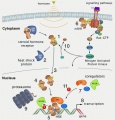File:Steroid hormone receptor signaling.jpg: Difference between revisions
No edit summary |
|||
| Line 20: | Line 20: | ||
Original file name: Figure 2 Big_nrs05003.f2.gif http://www.nursa.org/ejournal/published/05003/big_nrs05003.f2.gif | Original file name: Figure 2 Big_nrs05003.f2.gif http://www.nursa.org/ejournal/published/05003/big_nrs05003.f2.gif | ||
===Reference=== | |||
= | <pubmed>17464358</pubmed>| [http://www.ncbi.nlm.nih.gov/pmc/articles/PMC1853070 PMC1853070] | [http://www.nursa.org/article.cfm?doi=10.1621/nrs.05003 Nucl Recept Signal.] | ||
Copyright © 2007, Griekspoor et al. This is an open-access article distributed under the terms of the Creative Commons Non-Commercial Attribution License, which permits unrestricted non-commercial use distribution and reproduction in any medium, provided the original work is properly cited. | Copyright © 2007, Griekspoor et al. This is an open-access article distributed under the terms of the Creative Commons Non-Commercial Attribution License, which permits unrestricted non-commercial use distribution and reproduction in any medium, provided the original work is properly cited. | ||
[[Category:Molecular]] [[Category:Endocrine]] | [[Category:Molecular]] [[Category:Endocrine]] [[Category:Cartoon]] | ||
Revision as of 06:47, 26 September 2011
Steroid hormone receptor signaling
Steroid Hormone Receptors (SHR) act as hormone dependent nuclear transcription factors. Upon entering the cell by passive diffusion, the hormone (H) binds the receptor, which is subsequently released from heat shock proteins, and translocates to the nucleus. There, the receptor dimerizes, binds specific sequences in the DNA, called Hormone Responsive Elements or HREs, and recruits a number of coregulators that facilitate gene transcription. This latter step can be modulated by receptor antagonists like tamoxifen (T), and cellular signalling pathways.
Legend
- hormone binding
- chaperone interaction
- nuclear translocation
- receptor dimerization
- DNA binding
- putative membrane-bound receptors
- coregulator recruitment
- transcription
- proteasomal degradation
- modulation by cellular signalling pathways
- antagonist resistance
Original file name: Figure 2 Big_nrs05003.f2.gif http://www.nursa.org/ejournal/published/05003/big_nrs05003.f2.gif
Reference
<pubmed>17464358</pubmed>| PMC1853070 | Nucl Recept Signal.
Copyright © 2007, Griekspoor et al. This is an open-access article distributed under the terms of the Creative Commons Non-Commercial Attribution License, which permits unrestricted non-commercial use distribution and reproduction in any medium, provided the original work is properly cited.
File history
Yi efo/eka'e gwa ebo wo le nyangagi wuncin ye kamina wunga tinya nan
| Gwalagizhi | Nyangagi | Dimensions | User | Comment | |
|---|---|---|---|---|---|
| current | 18:11, 5 October 2010 |  | 800 × 835 (105 KB) | S8600021 (talk | contribs) | ==Steroid hormone receptor signaling== Steroid Hormone Receptors (SHR) act as hormone dependent nuclear transcription factors. Upon entering the cell by passive diffusion, the hormone (H) binds the receptor, which is subsequently released from heat shock |
You cannot overwrite this file.
File usage
The following 4 pages use this file: